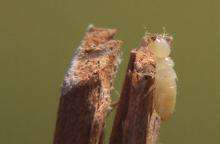Birds do it, bees do it; termites don't, necessarily

Scientists at North Carolina State University and three universities in Japan have shown for the first time that it is possible for certain female termite "primary queens" to reproduce both sexually and asexually during their lifetimes.
The asexually produced babies mostly grow to be queen successors - so-called "secondary queens" - that remain in the termite colony and mate with the king. This produces large broods of babies without the dangers of inbreeding, as secondary queens have no genes in common with the king.
Babies produced the old-fashioned way, between either the primary or secondary queens and the king, are mostly workers and soldiers of both genders, the research shows.
The research is published in the March 27 edition of the journal Science.
Dr. Ed Vargo, associate professor of entomology at NC State and a co-author of the paper, says that the species of subterranean termite studied, Reticulitermes speratus, is an important economic pest in Japan and is in the same genus as termites found in North Carolina.
Termite colonies are generally founded and then sustained by a primary king and primary queen. In the study, the scientists collected termites from a number of different colonies in Japan. In many colonies, the primary queen was not present, but had been seemingly succeeded by numerous secondary queens. Most primary kings, meanwhile, were present in the colonies. This suggests, Vargo says, that the primary kings live longer than the primary queens, so there is a strong need for these termites to have genetically diverse queen successors to grow the colonies efficiently.
Vargo's genetic analysis of termite populations in several colonies showed that secondary queens shared genes with primary queens but not with primary kings, suggesting asexual reproduction. At the same time, male and female termite workers and soldiers had genetic traces of both the primary king and primary queen, suggesting sexual reproduction.
"The conditional use of sex is unusual in insects and was previously unknown in termites. This novel use of both sexual and asexual reproduction is a way for primary queens to maximize reproductive output allowing the colony to grow bigger and faster while maintaining genetic diversity and avoiding the disadvantages of inbreeding," Vargo says.
Vargo plans to continue this research by looking for other species of female termites with dual mating systems. He adds that learning more about the genetics behind reproduction could lead to ways of preventing the production of certain castes of termites - like the primary queens that reproduce in two ways - or ways of knocking out certain gene functions in those castes.
More information: "Queen Succession Through Asexual Reproduction in Termites" Authors: Kenji Matasuura, Hiroko Nakano and Toshihisa Yashiro, Okayama University; Edward L. Vargo and Paul E. Labadie, North Carolina State University; Kazutaka Kawatsu, Kyoto University; Kazuki Tsuji, University of the Ryukyus. Published: March 26, 2009, in Science
Source: North Carolina State University


















